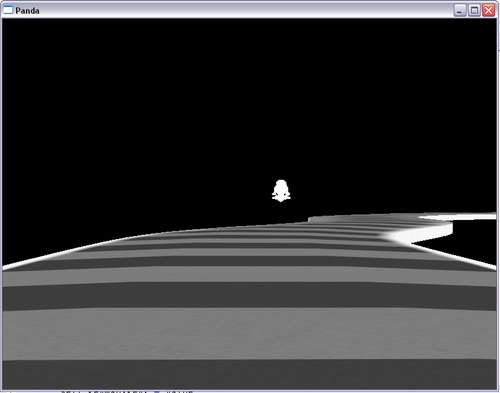- The first step to using a key map is to actually create the dictionary that serves the purpose. Right after the line that calls
self.cycle.setPos()method in the__init__method, insert the following block of code to create the dictionary:self.keyMap = {"w" : False, "s" : False, "a" : False, "d" : False} - Now we need to register events for the four keys in our key map. Replace the current
self.accept()call, with the following code:self.accept("w", self.setKey, ["w", True]) self.accept("s", self.setKey, ["s", True]) self.accept("a", self.setKey, ["a", True]) self.accept("d", self.setKey, ["d", True]) self.accept("w-up", self.setKey, ["w", False]) self.accept("s-up", self.setKey, ["s", False]) self.accept("a-up", self.setKey, ["a", False]) self.accept("d-up", self.setKey, ["d", False]) - Next, we need to change our
setKey()method to look like this:def setKey(self, key, value): self.keyMap[key] = value
- The key map is ready to go but we won't get any results at this point because we aren't using the key map for anything. To fix that, change the line where we add the
cycleMove1()method to the task manager from ataskMgr.doMethodLater ()call to ataskMgr.add()call and rename the method it uses.taskMgr.add(self.cycleControl, "Cycle Control"
- Scroll down to the
cycleMove1()method and change its name tocycleControl. We'll also add anifstatement to this method.if(self.keyMap["w"] == True): self.cycle.setY(self.cycle, 10 * dt)
- Our code should look like the following one when we're done:
import direct.directbase.DirectStart from direct.showbase.DirectObject import DirectObject class World(DirectObject): def __init__(self): base.setBackgroundColor(0, 0, 0) self.track = loader.loadModel("../Models/Track.egg") self.track.reparentTo(render) self.track.setPos(0,0,-5) self.cycle = loader.loadModel("../Models/Cycle.bam") self.cycle.reparentTo(render) self.cycle.setPos(2,15,0) self.keyMap = {"w" : False, "s" : False, "a" : False, "d" : False} taskMgr.add(self.cycleControl, "Cycle Control") taskMgr.doMethodLater(10, self.debugTask, "Debug Task") self.accept("w", self.setKey, ["w", True]) self.accept("s", self.setKey, ["s", True]) self.accept("a", self.setKey, ["a", True]) self.accept("d", self.setKey, ["d", True]) self.accept("w-up", self.setKey, ["w", False]) self.accept("s-up", self.setKey, ["s", False]) self.accept("a-up", self.setKey, ["a", False]) self.accept("d-up", self.setKey, ["d", False]) def setKey(self, key, value): self.keyMap[key] = value def cycleControl(self, task): dt = globalClock.getDt() if( dt > .20): return task.cont if(self.keyMap["w"] == True): self.cycle.setY(self.cycle, 10 * dt) return task.cont def debugTask(self, task): print(taskMgr) taskMgr.removeTasksMatching("Cycle Move *") return task.again w = World() run() - After doing all that, save the file as
chp04_02.pyand run it. While it's running press the W key and hold it for a second or two. Note that the Panda3D window needs to have focus to respond to keyboard input. If you click on another window or Alt+Tab for another window, the game won't respond to the keyboard anymore.

Now the cycle moves only when the W key is held down. That's because when the W key is pressed, the value for "w" in the key map changes to True, and when the key is released, the value changes back to False. The cycleControl task only moves the cycle forward when the value for "w" equals True.